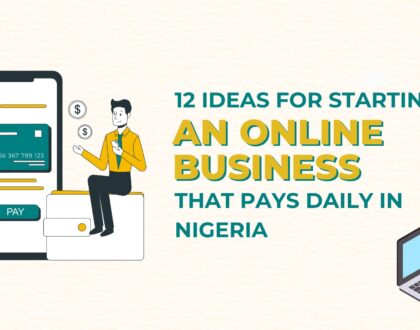9 Ways to Secure Business Funding When Required

Name one thing that gives business owners sleepless nights. I’ll wait
Yep, you guessed it: raising funds!
As a business owner, times may arise when raising funds for your business is required. For many entrepreneurs, this could be worse than dealing with difficult customers. And that’s not to say fundraising is super difficult (well, it is); it’s simply confusing and overwhelming if you don’t know what you’re doing.
That’s why we wrote this article. There are countless funding options available to propel the arduous entrepreneur to new heights. Here they are;
#1. Bootstrapping
Bootstrapping is going all the way to fund your businesses using your savings and assets, as opposed to looking for external funding from investors or lenders. This approach requires the entrepreneur to be highly resourceful, frugal, and creative in finding ways to grow the business without outside help.
Bootstrapping can involve:
- Using free or low-cost software.
- Leveraging existing networks for marketing and sales.
- Reinvesting profits into the business.
While bootstrapping can be challenging, it allows the entrepreneur to maintain control and ownership of the company and avoid the dilution of equity that comes with external funding. Bootstrapping can also be a way to validate the business model and demonstrate traction before seeking external funding.
If you need inspiration on your bootstrapping journey, you should read about Ben Chestnut, Mailchimp’s founder, who built a multimillion-dollar business without external funding or investments.
#2. Crowdfunding
Crowdfunding is a funding model where a large group of people contribute small amounts of money to support a project, product, or business idea—frequently done through online platforms that allow individuals or organisations to create a campaign and set a fundraising goal.
Crowdfunding campaigns can be reward-based, where backers receive a product or service in exchange for their contributions, or equity-based, where backers become partial company owners.
Crowdfunding has gradually become a sought-after alternative to traditional fundraising methods for entrepreneurs, artists, and social causes. It provides access to capital and a way to validate ideas through the crowd’s support.
#3. Angel Investors
Angel investors are high-net-worth individuals investing their money in startups or early-stage companies in exchange for equity ownership. They have typically experienced entrepreneurs or business executives who provide capital, expertise, and mentorship to the companies they invest in.
Angel investors differ from venture capitalists, who invest other people’s money in more established companies.
Angel investing is a high-risk, high-reward type of investment, and angel investors typically seek benefits through a liquidity event such as an acquisition or initial public offering (IPO). Angel investing can give startups the capital and support they need to grow their businesses.
Still, it also involves giving up a portion of ownership and control in the company.
#4. Venture Capitalists
Venture capitalists (VCs) are professional investors who provide capital to high-potential startups and early-stage companies in exchange for equity ownership.
They typically invest large amounts of money, often in the millions of dollars, and work closely with the companies they invest in to help them grow and succeed. VCs often bring funding, expertise, networks, and resources to help startups scale their operations.
VCs typically seek a significant return in exchange for their investment, usually through an acquisition or IPO.
Before sourcing funds from a VC, ensure you do your research and that the risk is worth it. This is a high-risk, high-reward type of investment that could cost or accelerate you. VCs typically invest in industries such as technology, biotech, and healthcare with the potential for high growth and profitability.
#5. Bank Loan
Banks still churn out loans to business owners. Don’t shy away from it.
Loans can be secured or unsecured, depending on whether the borrower provides collateral, such as property or assets, to ensure the loan. The loan amount and interest rate are typically based on the borrower’s creditworthiness, financial history, and loan repayment ability.
Bank loans are commonly used by businesses and individuals to finance projects, purchase assets, or cover expenses. They are hardly ‘investments’ in any sense and do not purchase equity in your business. The bank wants interest on the loan.
While bank loans can provide a reliable source of capital, they often require a lengthy application process and collateral. The inability to refund the loan can result in defaulting and damage the borrower’s credit score.
#6. Small Business Administration (SBA) Loans
The SBA provides loans to small businesses through its network of approved lenders. SBA loans typically proffer lower interest rates and more extended repayment than traditional bank loans.
#7. Grants
Dn’t forget grants. The good ole’ way governments or agencies support business owners.
Grants are funding opportunities government agencies, foundations, and other organisations provide. However these funds can be paid, but the application process can be competitive and time-consuming.
#8. Business Incubators and Accelerators
Incubators and accelerators are programs designed to provide funding, mentorship, and other resources to startups in exchange for equity. They can be a great way to get started and connect with other entrepreneurs and investors, especially if you’re running a startup.
#9. Initial Public Offering (IPO)
Initial Public Offering (IPO) is usually the last resort for most entrepreneurs whose businesses have grown large. IPO is offering your company shares to the public in exchange for funds.
You do this by offering its shares to the public for the first time. Your company hires an investment bank to underwrite the IPO and sets an initial price for its shares based on market demand and the company’s valuation.
If your business operates in the UK, the shares are offered to the public through a stock exchange, such as the London Stock Exchange or NASDAQ. The company receives capital from selling its shares, which investors can buy and sell in the secondary market. IPOs are often used by companies to raise capital for expansion or to provide liquidity to existing shareholders.
While IPOs can offer a significant amount of money and increased visibility for a company, they also require extensive regulatory compliance, public scrutiny, and ongoing reporting requirements.
Conclusion
These are ten funding options available to businesses. Each option has advantages and disadvantages, and it’s essential to consider which option is best for your business.
It’s recommended to consult with a financial advisor or accountant to help you make the best decision for your business.
Recommended Posts

12 Ideas For Starting An Online Business That Pays Daily In Nigeria
October 31, 2024

5 Reasons To Avoid Using GB Instagram To Promote Your Business
October 17, 2024

How To Apply For SMEDAN Loan For Your Small Business
October 7, 2024
